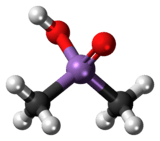Cacodylic acid
 | |
 | |
| Names | |
|---|---|
| IUPAC name
Dimethylarsinic acid | |
| Other names
Dimethylarsenic acid, Cacodylic acid, Hydroxydimethylarsine oxide, Arsecodile, Ansar, Silvisar, Phytar 560, DMAA, UN 1572 | |
| Identifiers | |
| 75-60-5 | |
| 3D model (Jmol) | Interactive image |
| ChEBI | CHEBI:29839 |
| ChemSpider | 2418 |
| DrugBank | DB02994 |
| ECHA InfoCard | 100.000.804 |
| EC Number | 200-883-4 |
| KEGG | C07308 |
| PubChem | 2513 |
| RTECS number | CH7525000 |
| UNII | AJ2HL7EU8K |
| |
| |
| Properties | |
| C2H7AsO2 | |
| Molar mass | 137.9977 g/mol |
| Appearance | White crystals or powder |
| Odor | odorless |
| Density | > 1.1 g/cm3 |
| Melting point | 192 to 198 °C (378 to 388 °F; 465 to 471 K) |
| Boiling point | > 200 °C (392 °F; 473 K) |
| 66.7 g/100 ml | |
| Solubility | soluble in ethanol, acetic acid insoluble in diethyl ether |
| Acidity (pKa) | 1.57 |
| Structure | |
| triclinic | |
| Hazards | |
| Safety data sheet | External MSDS |
| EU classification (DSD) |
|
| R-phrases | R26/27/28, R40 |
| Lethal dose or concentration (LD, LC): | |
| LD50 (median dose) |
700 mg/kg (rat, oral) |
| Except where otherwise noted, data are given for materials in their standard state (at 25 °C [77 °F], 100 kPa). | |
| | |
| Infobox references | |
Cacodylic acid is the chemical compound with the formula (CH3)2AsO2H. Derivatives of cacodylic acid, cacodylates, were frequently used as herbicides. For example, "Agent Blue," one of the chemicals used during the Vietnam War, is a mixture of cacodylic acid and sodium cacodylate. Sodium cacodylate is frequently used as a buffering agent in the preparation and fixation of biological samples for electron microscopy.
History
Significant early research into cacodyls was done by Robert Bunsen at the University of Marburg. Bunsen said of the compounds, "the smell of this body produces instantaneous tingling of the hands and feet, and even giddiness and insensibility...It is remarkable that when one is exposed to the smell of these compounds the tongue becomes covered with a black coating, even when no further evil effects are noticeable". His work in this field led to an increased understanding of the methyl radical.
Cacodyl oxide, ((CH3)2As)2O, is often considered the first organometallic compound to be prepared synthetically.
Cacodylic acid and its salts were incorporated into herbicides by large variety of manufacturers under numerous brand names. APC Holdings Corp. sold Cacodylic acid and its salts under the Phytar brand name.[1] The variety used in Vietnam (as Agent Blue) was Phytar 560G.[2]
Synthesis and reactions
In the 18th century it was known that combining As2O3 and four equivalents of potassium acetate (CH3CO2K) gives a product called "Cadet's fuming liquid" which contains cacodyl oxide, ((CH3)2As)2O and cacodyl, ((CH3)2As)2.
Cacodylic acid can be reduced to dimethylarsine (III) derivatives, which are versatile intermediates for the synthesis of other organoarsenic compounds:[3][4]
- (CH3)2AsO2H + 2 Zn + 4 HCl → (CH3)2AsH + 2 ZnCl2 + 2 H2O
- (CH3)2AsO2H + SO2 + HI → (CH3)2AsI + SO3 + H2O
Health effects
Cacodylic acid is highly toxic by ingestion, inhalation, or skin contact. Once thought to be a byproduct of inorganic arsenic detoxification, it is now believed to have serious health consequences of its own. It has been shown to be teratogenic in rodents, most often causing cleft palate but also fetal fatality at high doses. It has been shown to be genotoxic in human cells, causing apoptosis and also decreased DNA production and shorter DNA strands. While not itself a strong carcinogen, cacodylic acid does promote tumors in the presence of carcinogens in organs such as the kidneys and liver.
See also
References
- ↑ Stanley A. Greene (2005). Sittig's Handbook of Pesticides and Agricultural Chemicals. William Andrew. p. 132. ISBN 978-0-8155-1903-4.
- ↑ Committee to Review the Health Effects in Vietnam Veterans of Exposure to Herbicides; Institute of Medicine (1994). Veterans and Agent Orange: Health Effects of Herbicides Used in Vietnam. National Academies Press. pp. 89–90. ISBN 978-0-309-55619-4.
- ↑ Feltham, R. D.; Kasenally, A. and Nyholm, R. S., "A New Synthesis of Di- and Tri-Tertiary Arsines", Journal of Organometallic Chemistry, 1967, volume 7, 285-288.
- ↑ Burrows, G. J. and Turner, E. E., "A New Type of Compound containing Arsenic", Journal of the Chemical Society Transactions, 1920, 1374-1383
- Kenyon, E. M.; Hughes, M. F. (2001). "A Concise Review of the Toxicity and Carcinogenicity of Dimethylarsenic Acid". Toxicology. 160 (1-3): 227–236. doi:10.1016/S0300-483X(00)00458-3.
- Elschenbroich, C; Salzer, A. (1992) Organometallics, 2nd Edition
- Bunsen Biography